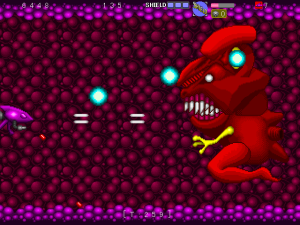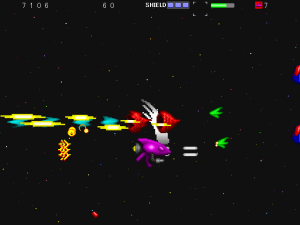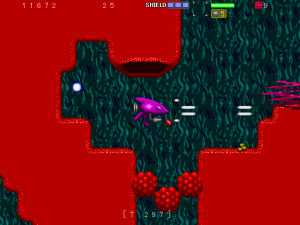Giant Cutter is half shmup, half not-quite-platformer, and completely bizarre. Taking place across four stages, the ship flies through space, cuts through enemies inside planets, and encounters increasingly-enormous bosses. There are no weapon upgrades and the normal attack has an unusually limited horizontal range, but the ship lives up to the game’s name as a portion of a constantly-refilling bar can be consumed to make a giant blade sprout forth from the top of the ship as it lunges forward across the screen to cut down anything in its path.
Each stage in Giant Cutter is divided into three distinct parts. The first part takes place in space and plays like a standard horizontal shmup where the ship gradually scrolls across the stage until it reaches a gateway embedded in a planet, which serves as the ‘goal’ and completes the section upon touching it. The second segment is where things get weird as you are given free control of the ship and must navigate through the labyrinthine insides of the planet to find and destroy several face-like structures within a time limit; the closest thing I can think of to compare these sections to is the Genesis game Sub-Terrania, though this comparison is still only a loose one at best. The final part of each stage is a boss fight and the actual structure of this part can vary a bit, but it generally starts with a short section with fixed scrolling and then returns to free movement for the boss fight itself. Five extra stages can also be unlocked after beating the game, though these only have interior areas without any boss fights or space travel.

The key to what makes the gameplay in Giant Cutter work as well as it does is the balance between the strengths and weaknesses of the ship’s capabilities. The rapid-fire normal attack only travels about halfway across the screen and doesn’t deal anywhere near as much damage as the blade, but it is very versatile. In addition to traveling in a straight line, your normal attack also hits a very small area above and below the front of the ship and also causes the ship to periodically drop bombs below it, which is essential for fighting many enemies in narrow, vertical sections of the interior areas. On the other side of things, the top-mounted blade is significantly stronger than your bullets and bombs, but it comes with a few downsides. In addition to costing part of an energy bar to use, the blade causes the ship to launch forward in whichever direction its facing; you can slow it down by holding the opposite direction and somewhat adjust the ship vertically during this lunge, but the ship itself remains vulnerable so timing and accuracy are absolutely necessary when using this attack. Many of the enemies are positioned near the top of the screen or near the ceiling where the basic attack has trouble hitting them, so learning to use this ‘giant cutter’ effectively quickly becomes mandatory, though wiping out groups of enemies with a single charge or rapidly destroying a stronger enemies with two charges in quick succession is really satisfying.
The risk associated with the blade charge is somewhat reduced by this game’s ship being more durable than usual. You don’t get much in the way of invincibility frames even after taking damage, so a poorly aimed charge can still cost a life, but your ship can take three hits before getting destroyed and you can hold on to a single item to use at will to either fully restore your health or fill up the cutter gauge in addition to a few scattered pickups which immediately fill a smaller portion of the gauge or give back one unit of health. Even with limited lives and no continues, the generous number of recovery items and the short length of the game itself, to say nothing of the overall low difficulty, make it easy to finish without getting a Game Over on your first time through.

It would be impossible for me to end an article on Giant Cutter without taking some time to talk about its aesthetics. Everything in this game has a sort of pseudo-3D, almost claymation quality to it, like something that fell out of near the end of the 16-bit era. Some of the enemies resemble the typical types of mechanical nemeses one would expect of a space-based shmup, but most of them are purely-organic monstrosities. In fact, the ‘planets’ themselves seem to be planet-sized creatures with fleshy walls and chunks of organic matter to cut through and enemies which more closely resemble cells and parasites than aliens in the interior sections. The concept of needing to fight your way through a planet which is literally alive has appealed to me ever since the NES shmup Abadox and, while Giant Cutter may not approach that particular cult classic in terms of sheer variety, it still pulls off the look remarkably well. The soundtrack also pulls its weight as there is a surreal quality to the music which matches the bizarre visuals, but most of the songs also are catchy or have a great sense of energy to them to match the fast slice-em-up gameplay.

With a short length and a difficulty which remains on the low side of the spectrum even if you include the more challenging extra stages, Giant Cutter is certainly sparse when it comes to content. Yet, what content it does have consists of wonderfully strange visuals and gameplay which is both creative and well-executed. Those looking to take on an adrenaline-fueled challenge may not particularly care for this game, but it will otherwise make for a great addition to many collections.